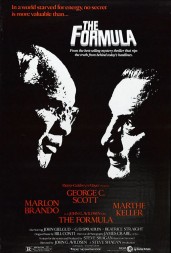The mysterious and secret formula under investigation in The Formula (1980) is the not-so-secret Fischer-Tropsch (F-T) formula, which had been known over half a century when the movie was made. The F-T process converts different solid or gaseous feedstocks, such as coal, biomass, or natural gas, into liquids. Solids are gasified into a synthetic gas (syngas) comprised of carbon monoxide and hydrogen, which can be subsequently converted into liquid hydrocarbons. Both coal-to-liquids (CTL) or gas-to-liquids (GTL) are processes using the F-T formula.
German scientists discovered the F-T process in the 1920s. (Side note: It seems German chemists claimed most of the influential discoveries between 1860 and 1920) Nazi Germany deployed the process widely during the Second World War as a way to turn abundant domestic coal reserves into liquid fuels they could use for the war effort. Since petroleum was imported from other countries, the F-T process provided a national security improvement for Germany in the face of blockades and embargoes that restricted their access to overseas oil.
South Africa also used the F-T formula to turn its coal into liquid fuels during Apartheid-related embargoes of the 1980s. The South African and German episodes demonstrate that coal-to-liquids can be done successfully, but society will only turn to this method in times of absolute necessity.
Notably, the F-T process is very carbon-intensive, especially if using coal as the feedstock. The 1980 version of The Formula focused on the secret catalyst that would supposedly solve the world’s energy crisis. Maybe a modern day remake of the movie would focus on an updated F-T formula that would eliminate the carbon emissions?



 Hydropower Saves The Fugitive
Hydropower Saves The Fugitive